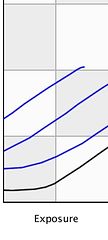A little more about the nuts and bolts of changing film speeds
Why film "looks" better at different speeds

Slices of films
I wrote previously about all of the possibilities for when you change the film speed on your camera. Right now, I'd like to address why people think a film "looks" better at different speeds.
To the left is a few 6-stop segments of Tri-X (in blue) and T-Max 100 (in black). For all the noise people make about how print film has so much dynamic range, it turns out (and I didn't entirely realize this on my own -- Ron Mowrey had to point this out) that when you print and develop at "standard" contrast, you are actually only getting between 5 and 6 stops of dynamic range. Your highlights and shadows are, by default, blocking up. And that's OK, because if you blindly try to show the whole dynamic range, it'll look flat and uninteresting.
A mythical "perfect" film would have a response curve that would look like a straight line on the H+D chart, but for a variety of reasons, it doesn't. So if we change the part of the response curve we use, we will get different results. What you are really doing is transforming the image.
Super high speed film
T-Max P3200 and Delta 3200 are both not truly 3200 speed films. Neopan 1600 is not a true 1600 speed film.
As I explained previously, film speed is defined as a particular toe speed at a given contrast.
All of these films are designed to be pushed, thus they are between 650 (for Neopan 1600) and 1200 (for Delta 3200) depending on developer and such, true toe speed. At the same time, they are low-contrast at those toe speeds, not standard contrast.
So, when you push one of these films, you end up with less shadow detail, but a normal level of contrast, so it will print normally but have especially black shadows. This is why these films are described as being designed for pushing.
Did you say 5-6 stops of dynamic range?

My process for editing a wide dynamic range print
Yes, I did. See, old black and white film shooters laugh and tell you about how many stops of dynamic range they can capture with no effort, compared to the pidly 5-6 stops of slide film. But what they forget to tell you is that it requires a certain amount of editing technique to make this happen.
To the right, I'm showing three stages of editing. The version on top preserves the entire captured dynamic range mapped fairly linearly. The version in the middle makes the skin tones be about where they should be with higher contrast, but you can see how the skies are totally blown out. The version on the bottom has the sky dodged, so that it isn't blown out, but still keeps the woman at the sort of contrast level you'd expect.
So, this is why you can get away with under or overexposing print film and get basically the same picture. Modern films try to have the response curve to be as straight of a line as possible, they just expose the paper a little more or a little less but keep the contrast of the paper the same to move the overall scene's exposure up and down. This is also the difference between a drugstore print and a careful scan or darkroom print.
There are, of course, other ways to fit the more-than-6 stop scene into a more normal range that don't require adjustment afterwards. This is usually when the old black and white film shooter will start making fun of you.
Speed enhancement
There are a variety of "Speed enhancing" developers or "fine grained" developers out there for black and white film.
With a given set of developer chemicals and adjuncts, you tended to be able to place the chemical formula on a point on a graph between definition, true film speed, and film grain. You could get finer grain and definition, but only at the expense of true film speed.. or you could get a little extra film speed, at the expense of grain and resolution.
With careful chemistry, you can also get the approximation of better definition and the approximation of better true film speed.
At a few points, new developing agents have been formulated that have greater developing efficiency than previous agents. XTOL is the biggest example.
Overall, the folks making chemicals for photographic developing have taken advantage of the decided lack of standard definitions of terms and generally advertise their developers as having excellent sharpness, fine grain, and at least a stop of extra speed. Except for Kodak, who actually make a chart that compares various developers properly.
I am quite annoyed about this practice, as I'm sure you can guess.
The degree thing
If you look on the film label of some films, you will sometimes see a degree symbol. Something like 400/27° or 100/21°
This is not a temperature. The degree symbol has many meanings and temperature is just one of them.... and the second number, the German DIN system number is about as useful as your appendix at this point.
Why does my film speed go down to ISO 6?
Because the first version of Kodachrome was ISO 6. Later versions of Kodachrome were ISO 12 and then ISO 25.
This is a two part series that I wrote because one of my friends asked a question and I realized that the answer was really really long. I also realized that people were asking the same sort of question over and over and over again in various online forums, so I might as well try and write up a good universal answer.












